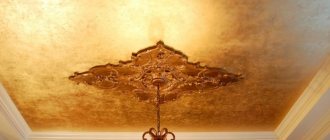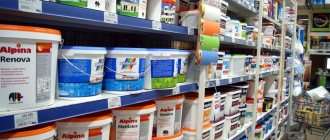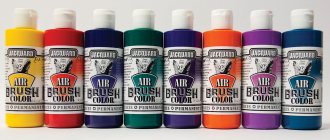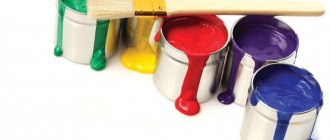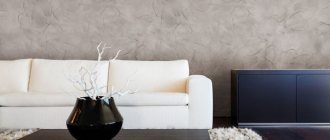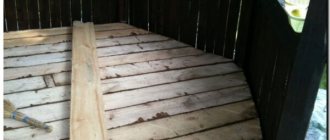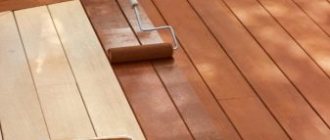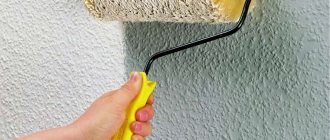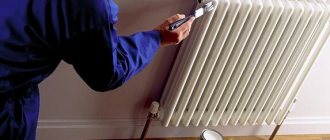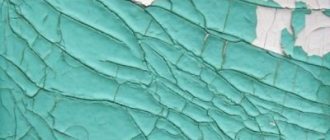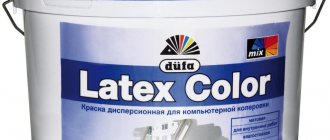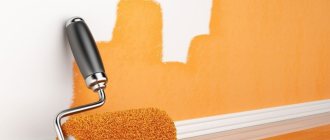Home / Painting tips / Selection rules / Which water-based paint to choose for the ceiling?
In the composition of paints and varnishes, one of the main roles is played by binders and solvents. They affect the paint’s ability to adhere to different surfaces, and also determine the level of resistance of the coating to external influences. Based on the type of solvent, coatings are divided into water- and organic-based ones. Paints of the first group, which can also be called water-dispersion, are more durable, wear-resistant and environmentally friendly, so they are recommended to be chosen for residential premises. All that remains is to figure out which water-based paint to choose for the ceiling and how to paint it correctly.
What are waterborne paints?
Water-based paints are often called water-based paints, while latex and acrylic paints are classified into different categories. But all these compositions are paints of the same type, formed by aqueous dispersion of polymers (latexes) with the addition of various fillers, pigments and other components. A water emulsion is a mixture of very small particles suspended in water. While the paint is in the can, microscopic polymers and additional components do not combine with each other and do not dissolve. Already during the painting process, when the paint is applied to the surface, the water begins to gradually evaporate and the spaces between the particles decrease. After complete compression, a dense film is formed, which, when dried, provides a reliable protective and decorative coating.
Water-based or latex paint should be designated as “water-based”. Depending on the polymer binders, such a coating can be:
- acrylic;
- styrene-acrylic;
- polyvinyl acetate (PVA);
- other types.
Manufacturers can designate aqueous dispersions as acrylic or acrylate - these are also the same concepts.
Types of water-based paints by composition, characteristics
Under the designation “water-based emulsion for painting the ceiling” lies a whole niche of paint and varnish products. They are available with different compositions. There is a slight difference in their cost, quality of coating and recommendations for use.
Under the designation “water-based emulsion for painting the ceiling” lies a whole niche of paint and varnish products.
Based on PVA
Polyvinyl acetate emulsion is a homogeneous composition of medium viscosity, white. This is not the most expensive dye; its durability leaves much to be desired. It has long been known to consumers and is produced in accordance with the requirements of GOST 28196 89. The composition resembles PVA construction adhesive (general component) with a thick consistency. At a temperature of +22°C, the semi-matte coating dries in 2-3 hours.
There may be problems with application to ceilings with whitewash (chalk and lime); it is advisable to wash it out and prime it.
The dye is easy to use and affordable. It will not lose its properties during short-term freezing, if storage conditions are briefly violated. Before painting the ceiling with water-based emulsion, it is recommended to stir it well.
Low water resistance is a disadvantage of PVA-based emulsion; it is good for dry residential areas. When adding pigment (color) to a white base, maintain the proportion. The color mixture is prepared for the entire treated area to be painted twice.
The dye is easy to use and affordable.
Based on acrylic resins
Acrylic paints are also hypoallergenic water-based compositions. This is one of the best interior options for any functionality; they do not fade in the light. A more moisture-resistant dye with excellent adhesion on any surface, which is how it differs from a simple emulsion with PVA.
It is not advisable to wash the ceiling with detergent containing abrasive substances - the film will be damaged. This recommendation applies to the care of any water-based emulsion paint job.
Acrylic compounds can be applied with a roller, brush or household spray. After painting the ceiling with water-based paint yourself, you can wash it after 2-3 days. The coating looks like freshly painted for a long time.
This is one of the best interior options for any functionality; they do not fade in the light.
Latex
Such compositions have “breathable” properties, although they form a film. Latex water-based emulsion with varying degrees of light reflection is an excellent product for the interior. With it, it is possible to paint ceilings with embossed foam blocks or wallpaper to be painted over a suitable primer.
It is difficult to answer which water-based paint is better, silicone, PVA or latex. It all depends on the functionality of the room. Latex compositions are suitable for the living room and hallway, as well as for the children's room and bedroom.
With it, it is possible to paint ceilings with embossed foam blocks or wallpaper to be painted over a suitable primer.
Silicate water emulsion
Silicate compositions are an aqueous solution of a suspended filler containing liquid glass, plasticizers and dye. They can also be used as exterior paint:
- On a balcony or loggia;
- In the covered terrace;
- On the veranda;
- For façade ceiling surfaces.
It is worth noting the durability of the silicate coating and its moisture resistance. Once you have correctly painted the ceiling with water-based paint, you can forget about repairs for many years. Persistent fungicides will protect the coating from mold and mildew.
It is worth noting the durability of the silicate coating and its moisture resistance.
Silicone
Silicone elastomers are the basis of this variety. They are suitable for most surfaces, offering superior aesthetics. The paint has a peculiar structure that fills small cracks and masks small defects.
The composition is not afraid of moisture, and is often used in finishing kitchens, bathrooms or toilets. Despite the thick film, the silicone water-based emulsion breathes, releasing moisture. The surface repels dirt, so it does not require frequent cleaning. The only negative is the high price.
The composition is not afraid of moisture, and is often used in finishing kitchens, bathrooms or toilets.
What are the differences and advantages
The types of components added to the acrylic composition determine the following differences between paints:
- specifications;
- price;
- life time;
- resistance to external influences;
- place of application.
Therefore, before purchasing, it is important to clearly determine which surfaces and in which rooms will be painted. In addition, factors of external influence on the coating (ultraviolet radiation, frequency of washing and cleaning, mechanical load, humidity, etc.) are analyzed. And since paint is necessary not only to protect the substrate from negative influences, but also for decoration, the color, texture and degree of matteness of the purchased composition are taken into account.
Among the advantages of water-dispersion paints are:
- durability (due to a high level of wear resistance and withstand high air temperatures);
- long-term preservation of color saturation (the coating does not turn yellow);
- versatility (the ability to apply the composition on many types of surfaces and in different rooms);
- dirt and moisture resistance (the film repels dust and drops of liquid);
- ease of cleaning (even with detergents);
- formation of a breathable coating that allows air to pass through;
- ease of use (dries quickly, easy to apply);
- safety for health and the environment (do not emit harmful volatile organic compounds).
The advantages include cost-effectiveness, which makes the latex composition more accessible, even despite the high cost of some types (for example, acrylic). But here it is necessary to take into account the factor of hiding power (the ability to overlap the contrasting substrate), which will affect the number of coating layers.
Advantages and disadvantages
The technical characteristics of water-based paint VAEK 1180 include its absolute non-flammability, neutral attitude towards aggressive environments and environmental friendliness.
White paint Source gidpokraske.ru
Other benefits:
- Easy to use. Can be diluted with plain water from a tap or well; after use, the instrument can also be easily washed in running water.
- Non-toxic and hypoallergenic - suitable for use in children's institutions.
- Strong adhesion to many types of materials. Works well on putty, concrete, wood, plaster. The exception is metal surfaces - here you will have to choose a different type of enamel.
- After painting, you can immediately live in the room. Does not leave unpleasant odors characteristic of oil or synthetic enamel.
- Dries quickly. Design drying time is from 5 to 12 hours.
- During storage it remains smooth and uniform, does not delaminate or crumble.
- Painted walls are easy to clean without leaving streaks. Has antibacterial properties.
- Permits air (breathes), resists moisture. Can be used in the bathroom and kitchen.
There are some minor disadvantages:
- It is impossible to work at sub-zero temperatures. The aqueous solvent freezes, depriving the dye of its viscosity.
- No adhesion to glossy or metal surfaces. The reason is the same: the water component.
Walls painted with water-based emulsion Source remontidei.ru
What to look for when choosing
Before choosing waterborne paint for the ceiling, you should determine the room where it will be used. Polyvinyl acetate compounds are not suitable for rooms with high humidity (bathrooms, toilets, kitchens), as well as for areas with poor heating and exposed to low temperatures (dachas, basements, garages). Styrene-acrylic paints, on the contrary, tolerate moisture well, but can fade in sunlight. This material is more suitable for bathrooms, corridors, utility rooms, and storage rooms. An acrylic mixture without mixed polymers is almost universal in scope. It is more expensive than other types, but consumption and coverage are higher, which means less composition is required.
Although polymer paints are quite universal in relation to the surface of application, when purchasing you need to make sure that the paint can be used on a specific substrate (plasterboard, fiberboard, wood, metal, plaster, brick and others).
Preparing walls for painting
Worn surfaces with stains, cracks, chips and potholes are subject to repair. You can't paint them, it's a waste of material and time. Before starting painting work, the walls should be prepared.
- Wall cleaning.
Oil paint, old plaster and simply cracked areas are removed using a spatula. Oil paint is preheated with a construction hairdryer. The lime is soaked and washed off with a brush or hard sponge.
If the surface is smooth, you just need to remove the old coating - use a grinding machine.
- Sealing irregularities.
The cracks and cracks are carefully cleaned and slightly widened so that there are no loose edges left. Then putty or seal with silicone and leave until completely dry.
Dry areas are sanded smooth and dust is swept away.
- Decoration of corners.
Corners left neglected will ruin the beauty of the renovated room. They are decorated with a silicone corner and puttied. Then they clean and polish.
- Preparation of reinforced walls.
Surfaces with metal reinforcement are puttied to hide the mesh and make the wall smooth. To avoid rust, the metal part is treated or paint with anti-corrosion properties is selected.
Resistance to external influences
Environmental and human factors directly affect the service life of the selected coating. Durability indicators depend on:
- from light resistance to UV radiation;
- resistance to humidity, fungal infection;
- operational resistance (washing, dry cleaning, impacts, contact with hot objects, household pollution).
When purchasing, you should look on the packaging for special markings or indications that this type of paint is resistant to possible individual external factors. The composition must contain target components, for example light stabilizers or biocidal additives that prevent the spread of microorganisms. The class of paint resistance to washing is taken into account. The standards provide the following designations:
- class 1 (intensive repeated washing with detergents without abrasive small particles);
- class 2 (softer cleaning with non-abrasive detergents);
- class 3 (exceptionally easy cleaning with a foam sponge without detergents).
The temperature in the room also plays an important role when choosing. Water-dispersion paints are recommended to be used within +5…+30 degrees Celsius.
Painting the ceiling
Before painting the ceiling with water-based paint, you need to prepare the following tools:
- A roller with a long pile, necessary for applying paint to large areas (due to the long piles, proper absorption of a large amount of the water-based composition is ensured);
- A brush that allows you to carefully paint joints and seams in the ceiling structure;
- Small brush for spot painting;
- Container for rolling out paint rollers.
Applying paint to the ceiling surface must comply with a number of rules. So, if there is one window in the room, the first layer of paint must be applied parallel to the window opening, and the second - perpendicular, and you need to start from the side of the window. If there are two windows in the room, then the layers should be applied perpendicular to each other, gradually moving from the window towards the blank wall.
It is best to start the painting process itself from a corner area located at the maximum distance from the front door. First of all, the joints are coated with a brush so that the width of the strip does not exceed 5 cm. Then the same surface will need to be painted again using a roller.
Separate layers are applied at intervals of at least 8 hours - this is enough time for the paint to dry completely. This process cannot be accelerated by artificial methods - in this case, the properties of the paint will be impaired and the coating will not be of sufficient quality. Of course, no owner will strive for such a result.
Individual layers must be applied carefully but quickly. The thing is that a fresh layer of paint always stands out against the background of an already hardened one, so it is advisable to make an effort and avoid possible contrast so that the ceiling looks quite beautiful after all the work is completed.
Color and hiding power
Indicators such as hiding power and paint color are influenced by the pigments that make up the paintwork material. Most ceiling coverings are available in a universal white color, which also has the highest ability to cover a contrasting substrate. Application of high-quality water-dispersed snow-white paint is most often limited to 1–2 thin layers.
When a composition with a certain shade is required, tinting is used. Some paint and varnish sales departments have specialized tinting services that carry out the process automatically. Also, many manufacturers supplement their products with color mixing cards, allowing you to do everything manually. In this case, pigment paste or color paint is added to the white color. It is important that the color paste concentration does not exceed 10% for interior compositions, otherwise the properties of the coating will be impaired.
When buying paint, it is advisable to pay attention to the presence of a designation on the packaging about the possibility of tinting or clarify this nuance with the seller. It is also taken into account that certain colors and their shades (yellow, red, lilac, purple) have a low level of surface coverage. This will directly affect paint consumption, since to paint a dark substrate, instead of 1-2, 3-4 layers of coating will be required. An alternative solution is to tint the primer previously applied to the surface in the most similar color.
Choosing paint for the ceiling
To choose the most suitable water-based paint for a particular situation, you should use the following recommendations:
- First of all, you should pay attention to paints from well-known brands that have stood the test of time. The most popular products are Tikkurila, Caparol and Dulux.
- To finish the ceiling, you need to select a composition for the appropriate purpose. Ceiling paints do not drip or spread when applied. In addition, such materials have a much higher hardening rate.
- To bring the paint to the desired shade, you can do the necessary work yourself using coloring. In this case, it is worth mixing the paint so that in the end its amount exceeds the required amount by at least 10% - this reserve can be used in the future to update the coating. However, tinting often turns out to be too complicated for inexperienced craftsmen, and in this case it would be best to turn to specialists who have special equipment that allows them to mix the paint properly.
- All water-based paints contain water. Water freezes at subzero temperatures, causing the paint to lose its existing properties. To avoid encountering such problems, you should not purchase this finishing material in stores with unheated warehouses or on the market. However, it would be best to simply go to a specialized store and buy paint there - in this case, there is a guarantee of proper storage of the material and the absence of the likelihood of it being counterfeited.
- Don't discount the price factor. High-quality paints are more expensive, but their consumption during the finishing process will be less - i.e. Some of the funds will eventually pay for themselves.
By following these recommendations and correctly assessing the parameters given in them, you can choose a good paint that will adhere well to the ceiling throughout its allotted service life.
Decorative properties
In addition to paint color, factors affecting the appearance of the coating are:
- degree of gloss;
- light reflection;
- texture (its density, presence of special effects).
On labels in most cases there are indications of the degree of gloss, depending on which the paints are divided:
- to glossy,
- semi-gloss,
- semi-matte,
- matte,
- completely matte.
Moreover, even the saturation of gloss and matte may differ, and the reflection of light from different degrees of gloss occurs at different angles. Glossy paints do not scatter light particles as chaotically as matte paints. Manufacturers can also supplement each of the coatings with various special effects (rough texture, metallic sheen, etc.).
If the difficulty of choosing depends on gloss or matte, it is recommended to analyze the parameters of the room and the ceiling substrate. Glossy surfaces are brighter, make the room lighter (and lower), give a boost of energy and practically do not get dirty. But if the ceiling is poorly leveled or there are defects on it, gloss will only emphasize these features. Matte compositions can cope with this disadvantage, visually expanding the room, bringing calm to the atmosphere, and gently scattering light. Their disadvantage is a higher degree of contamination and difficulty in washing.
Useful little things
- Paint consumption is indicated by the manufacturer on the packaging. On average it is 150-250 grams per square meter when applying two layers.
- If you are tinting paint for a room, mix a volume 10 percent higher than calculated . Overspending is always possible, and it is usually unrealistic to achieve the same shade when re-tinting.
When tinting, mix the paint with a small margin.
- If you are offered paint at a price below 30 rubles per liter, most likely its quality is below any criticism. Pigments and polymers are imported from Europe, and their prices are constant for domestic and foreign producers. It is possible to achieve a serious reduction in cost only by neglecting the correct production technology.
- Water-based paint must be stored at temperatures above zero . After freezing and defrosting, it will lose its quality characteristics.
- It is necessary to paint with water-based emulsion at a temperature not lower than +5C. Otherwise, the thickening paint will lie unevenly and in a thick layer.
- Ceiling paint requires sanding each layer after application to a wooden surface. Unlike other paints, water-dispersed paints raise the wood pile.
- Paints that provide a glossy surface are more resistant to abrasion. Matte paints cannot be washed frequently (see Glossy ceiling paint: characteristics and methods of application).
- The best color for white paint is titanium dioxide. The water-based emulsion painted with it has a pure white color without any shades.
- It is common practice to use diluted water-based paint as a primer. However, it is not economically feasible: with comparable quality, primer is much cheaper than paint.
Primer is cheaper than paint. At the same time, it will significantly reduce its consumption and make the coating more durable.
Additional factors
When choosing paint, some additional features of the material are taken into account, which should include:
- consumption (surface area that can be painted in 1 layer using 1 liter of coating);
- drying speed (full curing takes from 1 week to 1 month);
- viscosity (painting the ceiling with very liquid compounds is accompanied by a high level of complexity, staining of clothes, walls, floors);
- manufacturer and place of purchase (the quality of the product and the likelihood of purchasing a counterfeit may directly depend on these indicators).
Even the highest quality composition, selected in all respects, will not perform at its best if the correct painting sequence is violated. It is important to prepare any surface for paint application, namely clean it, apply priming and leveling putty. It is recommended, if possible, to choose preparatory and coloring materials from the range of one manufacturer. It is also mandatory to strictly follow the instructions for the paint.
If you select water-based ceiling paint that matches the surface being painted and the room, the coating will last for many years without significant damage or deterioration in its appearance. And even when the price of the product is the decisive factor, it is important to remember that, having saved, you can very soon be faced with the need to repaint the ceiling.
Preparatory work
For high-quality paint application, the ceiling must be prepared in advance, which requires the following steps:
- The first step is to clean the ceiling surface. To wash off the whitewash, you need to moisten the ceiling with water using a roller. The whitewash layer is removed with a spatula, after which the ceiling is washed with a washcloth. The old water-based emulsion is first moistened with water several times at intervals of about 20 minutes, the room is ventilated, after which the paint can be carefully removed with a spatula.
- Next you need to level the surface of the ceiling. Usually, putty is used for this purpose, which allows you to level out all the defects present in the ceiling. To understand how to putty a ceiling, you should read the corresponding article.
- The next step is primer. The ceiling surface must be primed first of all in order to improve the adhesion of the paint to the overlap. It is advisable to select a primer of the same brand as the paint - this combination will give the best result.
The result of the painting itself directly depends on the quality of preparation.
Silicone
Silicone water-based ceiling paint is a water-based paint containing silicone resins. It can be applied to almost any type of surface.
Silicone water emulsion has many advantages. It is capable of hiding cracks up to 2 mm wide, has high resistance to moisture and good vapor permeability, as well as high hiding power. Often one coat of paint is enough to achieve a quality finish.
Among the disadvantages, it should be noted the rather high price for this type of paint and varnish products. Silicone water emulsions are most suitable for bathrooms and kitchens.
[custom_ads_shortcode1]
Useful tips on selection, painting and storage
When choosing this or that type of paint, you should start from the base on which it will be applied. If the ceiling that you plan to paint is not well prepared, then it is better to use matte paint. It will visually hide defects.
If the ceiling in the room is low, it is better to paint it with glossy paint. This will visually increase the space.
It is better to buy paint in stores where it is kept warm, since water-based emulsions do not like negative temperatures.
If you plan to paint the ceiling yourself, you must first study the technology of this type of repair work. Before painting, be sure to prime the surface and let it dry thoroughly. It is advisable to carefully study the coloring rules contained on the label of the purchased product. A prerequisite for high-quality, effective ceiling painting is maintaining the optimal temperature in the room where the work will be carried out.
It is best to paint the ceiling using a wide roller. Hard-to-reach places are painted with a wide paint brush. A high-quality coating is obtained only after applying a second layer of paint, which should be applied perpendicular to the first.
Before applying the second layer, the first one must dry thoroughly. Until the ceiling is completely dry, there should be no drafts in the room where the work was carried out and direct sunlight should not fall on the ceiling.
Paint and varnish products should be stored at positive temperatures. The jar lid must be tightly closed. It is up to the consumer to decide which water-based emulsion is best to choose for painting ceilings. A wide variety of types of these paint and varnish products will allow everyone to find the most suitable option in terms of price and quality.
Liked? Share on social media networks!
Among the options for decorating ceilings, experts consider painting to be the simplest and most economical, since it will not last long if you purchase a low-quality and impractical coating. To create a uniform and beautiful surface, you can opt for water-based paint, which consists of tiny plastic particles dissolved in water. After the water evaporates, an elastic and fairly strong film is formed on the ceiling.
In many ways, the choice of water-based paint for the ceiling is determined by the polymer included in its composition. Hence it can be: silicate; acrylic; mineral and silicone.
To create a uniform and beautiful surface, you can stop choosing
on water-based paint, consisting of tiny plastic particles dissolved in water. Their positive qualities include:
- non-toxic;
- ability to pass air and water vapor;
- the surfaces of the walls and ceiling can be washed;
- the best option for indoor use - they do not have a strong odor;
- economical consumption - one kilogram is enough to apply to 5 m² of surface;
- Possibility of painting over many materials.
Considering all the advantages, water-based paint does not have
worthy alternatives when painting the ceiling
In the domestic building materials market, the choice of paint for the ceiling is huge and consumers are often faced with the problem of which water-based paint to whitewash the ceiling with. Information about each type will help you make a decision. When using paints, you need to know their intended purpose in order to save not only yourself, but also those around you from all kinds of unforeseen situations.
Acrylic
. Their production is based on acrylic resins. Such paints are distinguished by their durability and strength; the ceiling painted with them looks great; when applied several times, small defects on the surface can be eliminated. Painting the ceiling with acrylic paint is done only after the plaster has completely dried (this takes about a month), since the film formed after painting does not allow steam and gases to pass through.
When using paints, you need to know their intended purpose in order to save not only yourself,
but also those around us from all kinds of unforeseen situations. Manufacturers also produce acrylic paints with the addition of latex, which gives them greater resistance to high humidity and mechanical stress and guarantees customers up to 5 thousand wet ceiling cleanings. This is an excellent water-based paint for repairing surfaces, but its big drawback is its high cost. Mineral. To produce this building material, slaked lime or cement is added. They are used primarily for painting over brick and concrete, although they are suitable for almost all wall and ceiling surfaces. These paints, with a fairly limited service life, are inexpensive. Silicate. To produce this type of paint, an aqueous solution of liquid glass is used, to which pigments are added. As a result, the painted surface can last about 20 years. They should not be used where there is a high level of humidity - this is the bathroom and kitchen. Silicone. These are compounds created with the addition of silicone resins. Silicone is the best water-based paint for the ceiling, which is reflected in the cost of the material. It is vapor-permeable, and water will drain from its surface without causing the slightest damage to the ceiling. Silicone water-based paint is compatible with many mineral surfaces and can paint over even two-millimeter cracks without prior puttying. Surfaces treated with it are not afraid of fungus. After applying the plaster, the ceiling can be painted immediately. After silicone paint, its surface is washed with a brush using a soap solution, without fear that the appearance will be damaged. When choosing water-based paint, pay attention to both its type (base) and the manufacturing company (more details: “
Which water-based paint to choose for the ceiling”). It is advisable to find out what customers think about this product. What is the best water-based paint for the ceiling - reviews on this topic can be found on the Internet. The company must be present on the building materials market for several years. The peculiarity of the production of such paints does not require sophisticated equipment, which is why low-quality products with catchy names appear in large quantities.
When choosing a water-based paint, pay attention to both its type (base),
and on the manufacturing company. If the manufacturer has been working for a long time and the brand is well-known, then experts advise trusting such products, for example, Tikkurila or Tex. It should be borne in mind that glossy water-based ceiling paint is highly resistant to abrasion, while matte-coated ceilings should not be washed frequently. The high-quality and multifunctional Dulux water-based ceiling paint, which has proven itself well when painting ceilings with water-based paint in rooms for various purposes, has received many positive reviews from professionals. It is applied to brick, concrete, plaster, asbestos cement, drywall, etc., and the humidity level can be any. Also popular among consumers is acrylic matte water-based ceiling paint Superweiss; it is used to paint concrete, brick, plastered, putty and plasterboard surfaces, as well as wallpaper, fiberboards and particle boards (read: “
Painting a plasterboard ceiling with water-based paint It is advisable to read the labels on the packaging - there should be an indication of compliance with GOST 28196-89. Paints produced according to specifications have a wide variation in quality, while thanks to GOST, control over the production process is guaranteed. Consumption of water-based ceiling paint may vary, and this parameter is indicated on the packaging. Taking into account the application of two layers, it is from 150 to 250 grams per m² (when tinting, a reserve of about 10% is needed). The best color for white paint is titanium dioxide (pro
